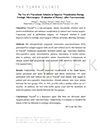The Use of a Viscoelastic Solution to Improve Visualization During Urologic Microsurgery: Evaluation of Patency After Vasovasostomy
Michael L. Eisenberg, Thomas J. Walsh, Paul J. Turek
Department of Urology, University of California San Francisco
San Francisco, California
Objectives
Viscoat® is a non-pyrogenic, sterile, viscoelastic solution used to protect endothelium and enhance visualization in cataract and corneal surgery. Since Viscoat® is commonly used in ophthalmic surgery, we evaluated whether it could improve optics in urologic microsurgery without adversely affecting outcomes.
“…The aim of the present study was to determine if the use of Viscoat® changed overall vasal patency rates, or time to patency compared to cases in which Viscoat® was not used. ”
– Dr. Paul Turek
Methods
We retrospectively compared consecutive vasovasostomies performed by a single surgeon with (n=23) and without (n=51) the bilateral use of Viscoat®. Examined parameters included patient age, vasectomy duration, intra-operative sperm characteristics, patency (ejaculation of motile sperm), time to patency, and post-operative semen characteristics. Comparisons of sample means and proportions were assessed with ANOVA, Wilcoxon and Chi-squared tests.
Results
Subjectively, Viscoat® improved visualization of the vasal lumen, suture placement and aided in resident and fellow instruction. Vasovasostomy cases performed with and without the use of Viscoat® were similar with regard to patient and intra-operative characteristics. Overall patency rates were similar between the two groups (91% vs. 92%, p=0.92) with a median follow-up of 7 months. In addition, the best total motile sperm count and the durability of achieved patency were similar between the two groups.
Conclusions
Viscoat® is a dispersive agent that does not adversely affect surgical patency after vasovasostomy. Subjectively, it is helpful to visualize the lumen of the vas deferens in urologic microsurgery.




 Viscoat® is a dispersive agent that does not adversely affect surgical patency after vasovasostomy. Subjectively, it is helpful to visualize the lumen of the vas deferens in urologic microsurgery.
Viscoat® is a dispersive agent that does not adversely affect surgical patency after vasovasostomy. Subjectively, it is helpful to visualize the lumen of the vas deferens in urologic microsurgery.









